+ Open data
Open data
- Basic information
Basic information
| Entry | Database: PDB / ID: 4hv8 | ||||||
|---|---|---|---|---|---|---|---|
| Title | Crystal Structure of H2Db-H155A-NPM6I | ||||||
 Components Components |
| ||||||
 Keywords Keywords | IMMUNE SYSTEM / viral immunity / T cell / H2Db / influenza / viral escape | ||||||
| Function / homology |  Function and homology information Function and homology informationEndosomal/Vacuolar pathway / DAP12 interactions / Antigen Presentation: Folding, assembly and peptide loading of class I MHC / ER-Phagosome pathway / DAP12 signaling / Immunoregulatory interactions between a Lymphoid and a non-Lymphoid cell / helical viral capsid / antigen processing and presentation of endogenous peptide antigen via MHC class I via ER pathway, TAP-dependent / cellular defense response / Neutrophil degranulation ...Endosomal/Vacuolar pathway / DAP12 interactions / Antigen Presentation: Folding, assembly and peptide loading of class I MHC / ER-Phagosome pathway / DAP12 signaling / Immunoregulatory interactions between a Lymphoid and a non-Lymphoid cell / helical viral capsid / antigen processing and presentation of endogenous peptide antigen via MHC class I via ER pathway, TAP-dependent / cellular defense response / Neutrophil degranulation / lumenal side of endoplasmic reticulum membrane / cellular response to iron(III) ion / iron ion transport / negative regulation of forebrain neuron differentiation / antigen processing and presentation of exogenous protein antigen via MHC class Ib, TAP-dependent / peptide antigen assembly with MHC class I protein complex / regulation of iron ion transport / regulation of erythrocyte differentiation / HFE-transferrin receptor complex / response to molecule of bacterial origin / MHC class I peptide loading complex / T cell mediated cytotoxicity / positive regulation of T cell cytokine production / antigen processing and presentation of endogenous peptide antigen via MHC class I / MHC class I protein complex / positive regulation of receptor-mediated endocytosis / negative regulation of neurogenesis / cellular response to nicotine / positive regulation of T cell mediated cytotoxicity / multicellular organismal-level iron ion homeostasis / viral penetration into host nucleus / phagocytic vesicle membrane / negative regulation of epithelial cell proliferation / sensory perception of smell / positive regulation of cellular senescence / T cell differentiation in thymus / host cell / negative regulation of neuron projection development / protein refolding / viral nucleocapsid / protein homotetramerization / amyloid fibril formation / intracellular iron ion homeostasis / learning or memory / ribonucleoprotein complex / external side of plasma membrane / symbiont entry into host cell / host cell nucleus / structural molecule activity / Golgi apparatus / protein homodimerization activity / extracellular space / RNA binding / plasma membrane / cytosol Similarity search - Function | ||||||
| Biological species |  | ||||||
| Method |  X-RAY DIFFRACTION / X-RAY DIFFRACTION /  SYNCHROTRON / SYNCHROTRON /  molecular replacement / Resolution: 2 Å molecular replacement / Resolution: 2 Å | ||||||
 Authors Authors | Gras, S. / Twist, K.A. / Rossjohn, J. | ||||||
 Citation Citation |  Journal: Proc.Natl.Acad.Sci.USA / Year: 2013 Journal: Proc.Natl.Acad.Sci.USA / Year: 2013Title: Preemptive priming readily overcomes structure-based mechanisms of virus escape. Authors: Valkenburg, S.A. / Gras, S. / Guillonneau, C. / Hatton, L.A. / Bird, N.A. / Twist, K.A. / Halim, H. / Jackson, D.C. / Purcell, A.W. / Turner, S.J. / Doherty, P.C. / Rossjohn, J. / Kedzierska, K. | ||||||
| History |
|
- Structure visualization
Structure visualization
| Structure viewer | Molecule:  Molmil Molmil Jmol/JSmol Jmol/JSmol |
|---|
- Downloads & links
Downloads & links
- Download
Download
| PDBx/mmCIF format |  4hv8.cif.gz 4hv8.cif.gz | 190.7 KB | Display |  PDBx/mmCIF format PDBx/mmCIF format |
|---|---|---|---|---|
| PDB format |  pdb4hv8.ent.gz pdb4hv8.ent.gz | 150.7 KB | Display |  PDB format PDB format |
| PDBx/mmJSON format |  4hv8.json.gz 4hv8.json.gz | Tree view |  PDBx/mmJSON format PDBx/mmJSON format | |
| Others |  Other downloads Other downloads |
-Validation report
| Summary document |  4hv8_validation.pdf.gz 4hv8_validation.pdf.gz | 476.6 KB | Display |  wwPDB validaton report wwPDB validaton report |
|---|---|---|---|---|
| Full document |  4hv8_full_validation.pdf.gz 4hv8_full_validation.pdf.gz | 481.1 KB | Display | |
| Data in XML |  4hv8_validation.xml.gz 4hv8_validation.xml.gz | 38.3 KB | Display | |
| Data in CIF |  4hv8_validation.cif.gz 4hv8_validation.cif.gz | 57.9 KB | Display | |
| Arichive directory |  https://data.pdbj.org/pub/pdb/validation_reports/hv/4hv8 https://data.pdbj.org/pub/pdb/validation_reports/hv/4hv8 ftp://data.pdbj.org/pub/pdb/validation_reports/hv/4hv8 ftp://data.pdbj.org/pub/pdb/validation_reports/hv/4hv8 | HTTPS FTP |
-Related structure data
| Related structure data | 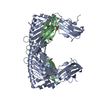 4huuC 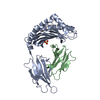 4huvC 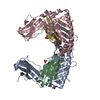 4huwC 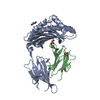 4huxC 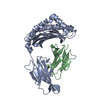 3cplS C: citing same article ( S: Starting model for refinement |
|---|---|
| Similar structure data |
- Links
Links
- Assembly
Assembly
| Deposited unit | 
| ||||||||
|---|---|---|---|---|---|---|---|---|---|
| 1 | 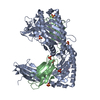
| ||||||||
| 2 | 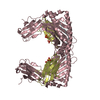
| ||||||||
| Unit cell |
|
- Components
Components
| #1: Protein | Mass: 32534.236 Da / Num. of mol.: 2 / Mutation: H155A Source method: isolated from a genetically manipulated source Source: (gene. exp.)   #2: Protein | Mass: 11791.545 Da / Num. of mol.: 2 Source method: isolated from a genetically manipulated source Source: (gene. exp.)   #3: Protein/peptide | Mass: 1008.062 Da / Num. of mol.: 2 / Source method: obtained synthetically / References: UniProt: Q5Q157*PLUS #4: Chemical | ChemComp-SO4 / #5: Water | ChemComp-HOH / | Has protein modification | Y | |
|---|
-Experimental details
-Experiment
| Experiment | Method:  X-RAY DIFFRACTION / Number of used crystals: 1 X-RAY DIFFRACTION / Number of used crystals: 1 |
|---|
- Sample preparation
Sample preparation
| Crystal | Density Matthews: 2.84 Å3/Da / Density % sol: 56.68 % |
|---|---|
| Crystal grow | Temperature: 298 K / Method: vapor diffusion, hanging drop / pH: 8.5 Details: 0.1M Tris HCl, 0.2M LiSO4, 25-30% PEG 8000, pH 8.5, vapor diffusion, hanging drop, temperature 298K |
-Data collection
| Diffraction | Mean temperature: 100 K | ||||||||||||||||||||||||||||||||||||||||||||||||||||||||||||||||||||||||||||||
|---|---|---|---|---|---|---|---|---|---|---|---|---|---|---|---|---|---|---|---|---|---|---|---|---|---|---|---|---|---|---|---|---|---|---|---|---|---|---|---|---|---|---|---|---|---|---|---|---|---|---|---|---|---|---|---|---|---|---|---|---|---|---|---|---|---|---|---|---|---|---|---|---|---|---|---|---|---|---|---|
| Diffraction source | Source:  SYNCHROTRON / Site: SYNCHROTRON / Site:  Australian Synchrotron Australian Synchrotron  / Beamline: MX1 / Wavelength: 0.956 Å / Beamline: MX1 / Wavelength: 0.956 Å | ||||||||||||||||||||||||||||||||||||||||||||||||||||||||||||||||||||||||||||||
| Detector | Type: ADSC QUANTUM 210 / Detector: CCD / Date: Jul 29, 2011 | ||||||||||||||||||||||||||||||||||||||||||||||||||||||||||||||||||||||||||||||
| Radiation | Protocol: SINGLE WAVELENGTH / Monochromatic (M) / Laue (L): M / Scattering type: x-ray | ||||||||||||||||||||||||||||||||||||||||||||||||||||||||||||||||||||||||||||||
| Radiation wavelength | Wavelength: 0.956 Å / Relative weight: 1 | ||||||||||||||||||||||||||||||||||||||||||||||||||||||||||||||||||||||||||||||
| Reflection | Resolution: 2→100 Å / Num. obs: 68339 / % possible obs: 99.3 % / Observed criterion σ(I): -3 / Redundancy: 3.7 % / Biso Wilson estimate: 31.85 Å2 / Rmerge(I) obs: 0.067 / Net I/σ(I): 13.5 | ||||||||||||||||||||||||||||||||||||||||||||||||||||||||||||||||||||||||||||||
| Reflection shell |
|
-Phasing
| Phasing | Method:  molecular replacement molecular replacement |
|---|
- Processing
Processing
| Software |
| ||||||||||||||||||||||||||||||||||||||||||||||||||||||||||||||||||||||||||||||||||||||||||||||||||||||||||||||||||
|---|---|---|---|---|---|---|---|---|---|---|---|---|---|---|---|---|---|---|---|---|---|---|---|---|---|---|---|---|---|---|---|---|---|---|---|---|---|---|---|---|---|---|---|---|---|---|---|---|---|---|---|---|---|---|---|---|---|---|---|---|---|---|---|---|---|---|---|---|---|---|---|---|---|---|---|---|---|---|---|---|---|---|---|---|---|---|---|---|---|---|---|---|---|---|---|---|---|---|---|---|---|---|---|---|---|---|---|---|---|---|---|---|---|---|---|
| Refinement | Starting model: PDB entry 3cpl Resolution: 2→72.93 Å / Cor.coef. Fo:Fc: 0.9475 / Cor.coef. Fo:Fc free: 0.9182 / Occupancy max: 1 / Occupancy min: 0 / SU R Cruickshank DPI: 0.155 / Cross valid method: THROUGHOUT / σ(F): 0
| ||||||||||||||||||||||||||||||||||||||||||||||||||||||||||||||||||||||||||||||||||||||||||||||||||||||||||||||||||
| Displacement parameters | Biso mean: 36.59 Å2
| ||||||||||||||||||||||||||||||||||||||||||||||||||||||||||||||||||||||||||||||||||||||||||||||||||||||||||||||||||
| Refine analyze | Luzzati coordinate error obs: 0.226 Å | ||||||||||||||||||||||||||||||||||||||||||||||||||||||||||||||||||||||||||||||||||||||||||||||||||||||||||||||||||
| Refinement step | Cycle: LAST / Resolution: 2→72.93 Å
| ||||||||||||||||||||||||||||||||||||||||||||||||||||||||||||||||||||||||||||||||||||||||||||||||||||||||||||||||||
| Refine LS restraints |
| ||||||||||||||||||||||||||||||||||||||||||||||||||||||||||||||||||||||||||||||||||||||||||||||||||||||||||||||||||
| LS refinement shell | Resolution: 2→2.05 Å / Total num. of bins used: 20
|
 Movie
Movie Controller
Controller



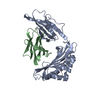



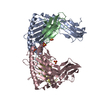





 PDBj
PDBj












